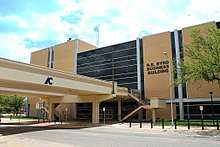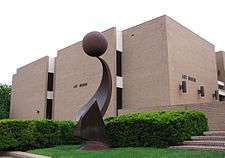Amarillo College
Amarillo College (AC) is a public community college in Amarillo, Texas. It enrolls over 10,000 students and was established in 1929 as Amarillo Junior College. Amarillo College has a total of six campuses as of October 2005.
 | |
| Motto | Collegium Excellens |
|---|---|
Motto in English | The College of Surpassing |
| Type | Community College |
| Established | 1929 |
Academic affiliation | Southern Association of Colleges and Schools |
| President | Dr. Russell Lowery-Hart |
| Students | 11,675 |
| Location | , , United States 35.188336°N 101.847089°W |
| Campus | Urban, 31 acres (13 ha), Washington Street campus |
| Colours | Blue and White |
| Mascot | Badger |
| Website | actx |
 | |
As defined by the Texas Legislature, the official service area of AC includes all of Carson, Castro, Deaf Smith, Moore, Oldham, Parmer, Potter, Randall, and Swisher Counties.[1]
History
Prior to 1929, Amarillo was the largest Texas city without a public college. George Ordway and James Guleke helped to introduce a house bill that would establish junior college districts in the Amarillo area. On July 16, 1929, Amarillo College (AC) became the first Texas junior college district to be organized independent of a school district. The first classes were held later that year in September with a total of 86 students in its first class. The college moved to its main campus on Washington Street in 1937 in what is now known as Ordway Hall.
During the time of the World Wars it seemed as though everything would be affected, and Amarillo College was no exception. Throughout the first half of the 1940s Amarillo College's Defense School and other classes trained for wartime building efforts. In 1942 the President of the college, Dr. Mead, was commissioned to the Army and forced to take a leave of absence to help in the war.
In 1951, Amarillo College became one of the first three publicly supported Texas college to have racially integrated undergraduate classes, and in 1953 AC had its first African American graduate. The other colleges to admit African Americans at the time were Texas Southmost College in Brownsville and Howard County Junior College in Big Spring. (The AC Story: Journal of a College, Joe F. Taylor, 1979)
Amarillo College was the host of a men's basketball team from the 1960s through several years in the 1970s. In 1970 the team was ranked 9th in the nation in pre-season rankings and spent a good part of the season in the top ten among junior colleges in the nation. The conference included New Mexico JC, Odessa College, Frank Phillips College, New Mexico Military Institute, Howard County College, South Plains College and Clarendon College.
The college also had a men's and women's tennis team as well as a men's golf team in the 1960s and 1970s. In 1971 the AC golf team finished sixth in conference action.
In 1999 the school's Fencing Team was initiated into the Amarillo College Fencing Association. Both clubs are sanctioned by the United States Fencing Association. Juleah Nusz, an Amarillo College fencer, is a national United States Fencing Association Champion, and under the guidance of Coach Chuck Slaughter.
Amarillo College reached a record enrollment number of over 10,000 students in 2004.
Campuses
Washington Street Campus

The college's main and original campus is located on Washington Street near downtown Amarillo. As of 2005, the campus expands to nearly 31 acres (130,000 m2) with 17 buildings. It owns radio and television stations, KACV-FM and KACV-TV; both respectively serve as a college/variety radio station and a PBS member public television station and broadcast from the Gilvin Broadcast Center. The Amarillo Museum of Art (AMoA), originally named the Amarillo Art Center, and the National History Museum is also located in this campus. The AMoA opened in 1972 and was renamed in the late 1990s.
The main campus formerly had a cafeteria but it stopped service after a reduction in the school's budget.[2]
West Campus
The West Campus is a 42-acre lot located near Amarillo's hospital district that officially opened its doors in 1967 in response to growing demand for allied health and occupational technology programs. Starting off with only four campus buildings, the campus later expanded to eight buildings after a successful bond election in 1994.[3] The campus houses fifteen allied health programs, including associate degrees in Registered Nursing, Dental Hygiene, Emergency Medical Services Professions (Paramedics and Emergency Medical Technologists) and many others. The West Campus also houses the Panhandle Regional Law Enforcement Academy, an academy accredited by TCLEOSE.
Amarillo College Downtown Campus
This campus is located in the heart of downtown Amarillo. In 1977, Amarillo College leased two gyms from the Amarillo Senior Citizens Association (ASCA), formerly of Amarillo High School and Elizabeth Nixson Junior High School. In 1996, the old Amarillo High School gymnasium was transformed into Business & Industry Center which houses an auditorium, an exhibit hall and classrooms for seminars, short courses and computer training. The facility is also used for workforce training for business industries.
East Campus

In 1995, the Texas state legislature created Amarillo Technical Center after transferring Texas State Technical College's Amarillo facility to Amarillo College. In 2002, the campus was renamed Amarillo College East Campus.
The campus offers courses in automotive and industrial fields. The campus is also sparsely developed, consisting of old buildings from the TSTC days (which itself were donated when Amarillo Air Force Base closed) and a residential community called Highland Park Village (consisting of old military housing duplexes, from which the nearby school district takes its name), currently managed by the college.
Campuses outside of Amarillo
In 2000 Amarillo College started operating a campus outside Amarillo in Dumas, Texas. The college opened a sixth campus in Hereford, the seat of Deaf Smith County, on August 29, 2005. KPAN AM&FM radio broadcaster Clint Formby raised $89,000 in scholarships for student attending the Hereford campus.[4]
Demographics
A 2017 survey determined that 11% of Amarillo College students were homeless in the period 2016-2017, and a total of 54% of the student body had difficulty obtaining food within one month of taking the survey. As a result of the high numbers of low income students, the school has made antipoverty initiatives.[2]
In 2010 the graduation rate was 9%, and focus groups and surveys concluded that poverty-related factors were the causes. The findings kickstarted the school's antipoverty programs.[2]
Notable alumni
- John C. Morgan, Medal of Honor recipient
- Ben Sargent, editorial cartoonist
- G. William Miller, Former United States Secretary of the Treasury and Chair of the Federal Reserve Bank.
- Larry Kenon, Former NBA player
- Susan Gibson, Songwriter and Vocalist, wrote "Wide Open Spaces"[5]
- Jinh Yu Frey, professional Mixed Martial Artist, current Invicta FC Atomweight Champion[6]
See also
References
- Texas Education Code, Section 130.164, "Amarillo College District Service Area".
- Bombardieri (2018-05-30). "Colleges Are No Match for American Poverty". The Atlantic. Retrieved 2018-05-31.
- "Amarillo College West Campus". www.actx.edu. Retrieved Feb 14, 2019.
- "The Old Philosopher". kpanradio.com. Archived from the original on February 24, 2009. Retrieved December 20, 2009.
- "AC One Step Toward Wide Open Spaces". Retrieved 2007-07-19.
- "Jinh Yu Frey – Invicta Fighting Championships". Retrieved Feb 14, 2019.
- Amarillo College from the Handbook of Texas Online. Accessed on October 8, 2005.
- "Amarillo College Campuses". Amarillo College. Retrieved December 31, 2005.